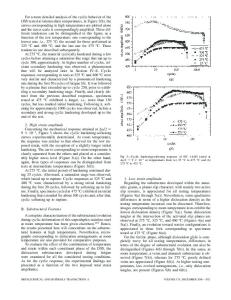Machinability evaluation of coated carbide inserts in turning of super-duplex stainless steel
- PDF / 3,671,918 Bytes
- 19 Pages / 595.276 x 790.866 pts Page_size
- 54 Downloads / 293 Views
Machinability evaluation of coated carbide inserts in turning of super‑duplex stainless steel Pranay Kumar Parsi1 · R. Sreeram Kotha1 · Thomas Routhu1 · Shashank Pandey1 · Maheshwar Dwivedy1 Received: 7 January 2020 / Accepted: 22 September 2020 © Springer Nature Switzerland AG 2020
Abstract Super-duplex stainless steel (SDSS) is a class of materials that possess excellent mechanical properties with enhanced corrosion resistance. Given the presence of several alloying elements and the existence of a two-phase microstructure, it can be argued that it is one of the few materials that are difficult to machine. Therefore, the present study attempts to establish an improved understanding of the state-of-the-art development in insert coatings capable of providing excellent tribological and thermal resistance properties. In this work, monolayers of AlTiN and AlCrN are PVD coated on commercial carbide inserts so as to compare and contrast the performance of nitride coatings in the dry turning of SDSS. This study evaluates the machining performance in terms of tool wear, chip characteristics, tool life and surface finish. The coated surfaces were observed through optical microscope, profilometers, scanning electron microscope and energydispersive X-ray spectroscopy to evaluate the morphological changes. The results of the work indicate that machining with PVD-coated AlTiN insert showed longer tool life, better surface finish and smaller chip thickness when compared to AlCrN-coated and uncoated inserts at low to moderate cutting speeds. The dominant wear mechanism was found to be adhesion, where during turning long continuous chips were formed for uncoated inserts and small segmented chips were formed for coated inserts at different machining parameters. Contrarily, the study also purportedly explores the improved performance of AlCrN-coated inserts over AlTiN-coated inserts at high cutting speed. Keywords Super-duplex stainless steel · Abrasion · Adhesion · Diffusion · Flank wear · Crater wear · Insert · Coating
1 Introduction The rising demands from various industrial sectors, including petrochemical, oil and gas exploration; desalination and seawater systems; marine engineering, express the need for materials having superior mechanical performance under scarring environments. The equipment operating under severe corrosive work conditions is exposed to critical operating conditions involving high temperatures and pressures and also exposed to harsh chemicals. Superduplex stainless steels (SDSS) are a class of materials that
are extremely corrosion resistant and work-hardenable alloys, widely used in applications involving corrosive environment. Super-duplex steels have brilliant mechanical properties providing both high strength and good corrosion resistance, compared to their cost. These steels combine the characteristics of both ferrite and austenitic steels. The cost factor of SDSS is another reason for its superiority over other material options as it offers to be an economical alternative over nickel alloys, stai
Data Loading...











